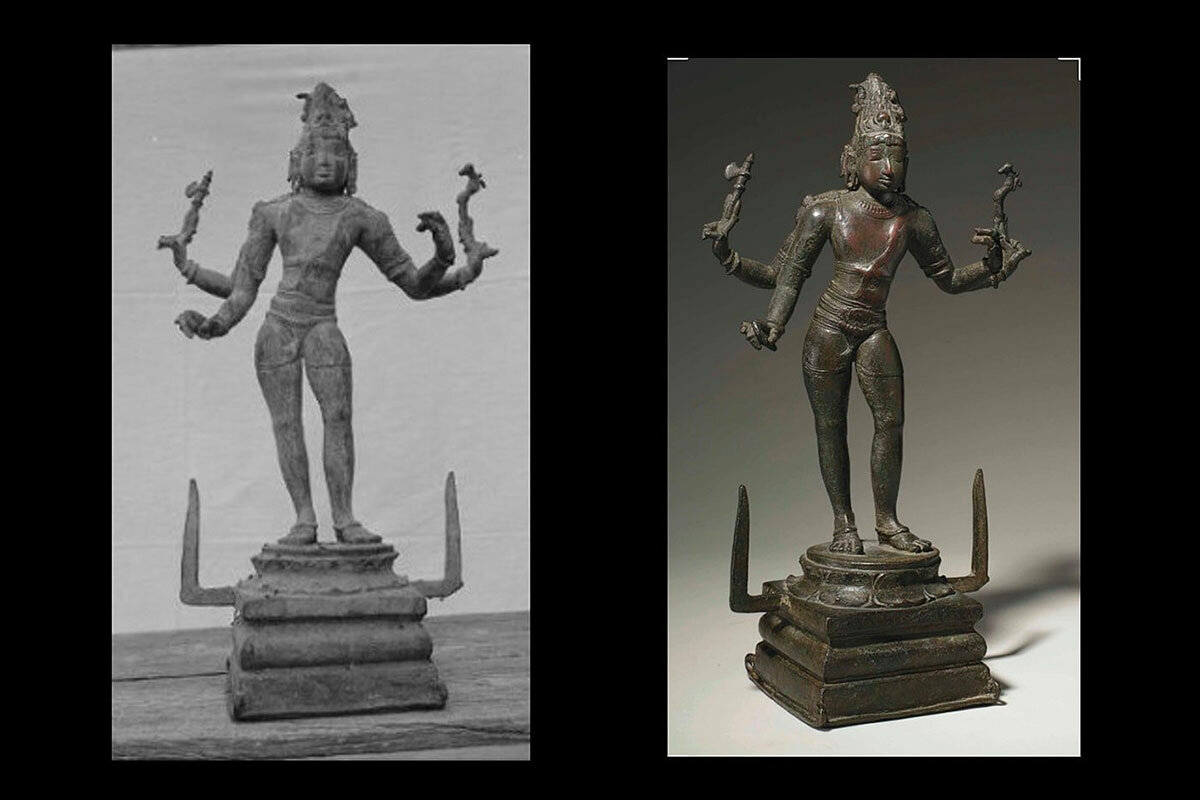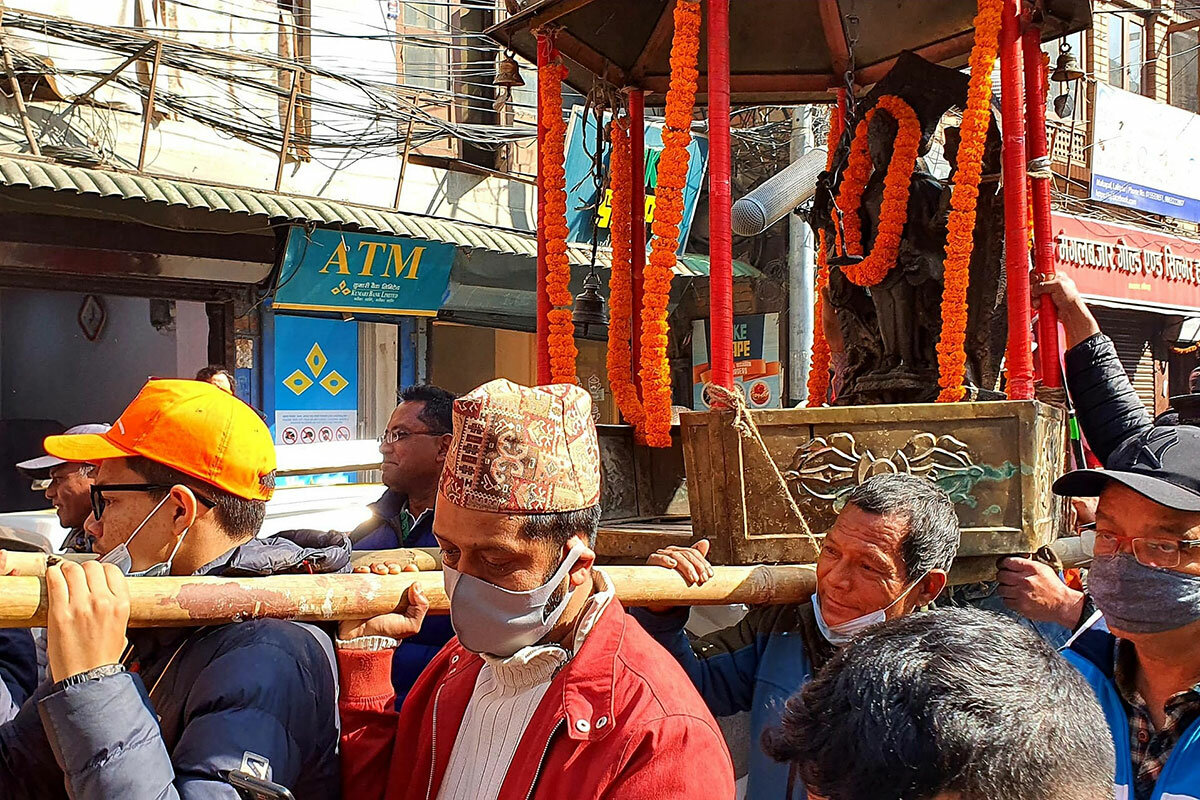Meet the amateur art sleuths helping bring back Asia’s stolen heritage
Loading...
Illicit trade of cultural property is the third-largest international criminal activity, surpassed only by drug and arms trafficking. In recent years, a movement to bring back artifacts looted from temples across Asia has gained momentum with the help of heritage enthusiasts like Vijay Kumar, who works in the shipping industry but has harbored a lifelong passion for Indian art.
Collaborating over Facebook groups, Mr. Kumar and other hobbyists spend their spare time scouring virtual museum catalogs and auction listings to identify stolen items, as well as urging authorities to hold the art world accountable. At the heart of their slow and often frustrating work is a quest for justice and a sense of patriotic duty.
Why We Wrote This
A story focused onBehind the return of stolen artifacts to Asia is a network of volunteer art sleuths working together to preserve their cultural heritage. They’re driven not only by a sense of national responsibility, but also by a shared desire for justice.
Experts in art theft attest that through dedication and cooperation, these amateur investigators punch well above their weight. Thanks in part to evidence they’ve gathered, artifacts have begun trickling back to South Asia. The United States alone handed over about 250 antiquities estimated to be worth $15 million to India last year.
“We still feel that we are scratching the surface. That’s what keeps us going,” says Mr. Kumar. “We are like the Avengers.”
Growing up, Vijay Kumar’s favorite book was a Tamil historical fiction novel that told tales of a mighty king who ruled over southern India, where Mr. Kumar is from. It sparked in him an interest in ancient Indian history, particularly temples and the shrines and sculptures that filled them.
“I wanted to visit the places mentioned in the book, look at the small bits of history and feel the inscriptions,” says Mr. Kumar, now in his late 40s.
Little did he know that his interest in Indian artifacts would one day help nab some of the world’s biggest art criminals.
Why We Wrote This
A story focused onBehind the return of stolen artifacts to Asia is a network of volunteer art sleuths working together to preserve their cultural heritage. They’re driven not only by a sense of national responsibility, but also by a shared desire for justice.
For decades, thieves have been looting temples and monasteries across Asia and smuggling their haul overseas where it often ends up in the top museums and auction houses of the world. Illicit trade of cultural property is the third-largest international criminal activity, surpassed only by drug and arms trafficking.
In recent years, there has been a burgeoning movement to bring back the stolen art, and hobbyists like Mr. Kumar are the backbone of these efforts. Collaborating over Facebook groups, he and other heritage enthusiasts spend their spare time scouring virtual museum catalogs and auction listings to identify stolen items, as well as urging authorities to hold the art world accountable.
As a result, artifacts have begun trickling back to South Asia. The United States alone handed over about 250 antiquities estimated to be worth $15 million to India last year. Museums have also returned artifacts to Nepal, the most recent being a 13th-century wooden sculpture of a tree deity that had been with the Metropolitan Museum of Art in New York since 1991 and was repatriated in August.
Every single return motivates the volunteer sleuths to keep digging. At the heart of their slow and often frustrating work is a quest for justice and a sense of patriotic duty. Although they’re based on different continents and rarely meet, Mr. Kumar and his fellow volunteers share a unique camaraderie born out of a desire to correct historical wrongs.
“We are happy with what we’re doing, but we still feel that we are scratching the surface. That’s what keeps us going,” says Mr. Kumar. “We are like the Avengers.”
The making of an art sleuth
It all started in the early 2000s, when Mr. Kumar and his friends began taking weekend trips to visit obscure temples, only to find that the idols and intricately carved sculptures that adorn temple compounds were often missing. They also noticed that a lot of Indian pieces in museums or auction houses abroad had ominous clues of theft: chisel marks at their base, vague descriptions of how the object had been acquired, and traces of vermilion pigment indicating the idols had been in active worship.
So they started documenting their findings. Mr. Kumar and his friends formed Facebook groups of like-minded people, including people who were living abroad and could check out artifacts in person. Others scanned books on Indian art to build a repository of idols in situ. Once they had a sizable database, Mr. Kumar and his core group of volunteers began the process of matching the items described in the books to artifacts overseas.
It’s a meticulous task that involves looking for unique markers like discoloration, dents, or inscriptions.
“Some [of the idols] we search for three or four years,” says Mr. Kumar. “Some of them happen in a night.”
Soon, law enforcement in the U.S. and other countries investigating art theft started contacting Mr. Kumar’s group for help. A big breakthrough came in 2010 when Mr. Kumar’s team tracked down an archival photo of an 800-year-old bronze Nataraja, a sculpture of the dancing Hindu god Shiva, that had been stolen from a small village in southern India. It turned out to be a vital piece of evidence against New York-based art dealer Subhash Kapoor, who had smuggled artifacts worth approximately $140 million and was arrested in 2011.
Mr. Kumar later founded the India Pride Project, which now has nearly 8,000 volunteers spread across the globe. Some disappear for months on end due to family or work commitments, but they almost always resurface, he says. Most have no formal training in art or history. Mr. Kumar works in the shipping industry, and his core group consists of a techie, an auditor, and an engineer.
“We are not special,” he says. “We’re common citizens who are just using a bit of common sense.”
But experts in art theft attest that through cooperation and commitment, these amateur investigators punch well above their weight. CEO and founder of London-based Art Recovery International Christopher Marinello says the volunteers’ research and his team’s legal skills together are “a considerable force in encouraging the possessors of looted objects to give up without a fight.”
Work of devotion
Locating a stolen idol is only half the battle. Often, idols remain on display in museums for years after they’ve been identified as stolen. That’s where volunteers like Slok Gyawali come in.
Mr. Gyawali maintains an Excel spreadsheet of cold cases based on leads posted by the anonymous administrator of a Facebook account called Lost Arts of Nepal. Whenever he has free time, the Portland-based sustainability consultant contacts museum authorities, presenting evidence gathered by volunteers and asking them to share the idol’s provenance.
“They usually tell me to bugger off,” he says.
One case that has been on his mind for a long time is a copper necklace of the goddess Taleju Bhawani, a patron deity of Nepali royals, which has been with the Art Institute of Chicago since 2010. Despite being located years ago, it hasn’t been returned to Nepal, where Mr. Gyawali is originally from.
He feels frustrated by his inability to send the deity home, especially around the festival of Dashain — the only day when the goddess’ temple in Kathmandu is open to the public.
“These are works of devotion, of art, and they mean something,” says Mr. Gyawali, a devout Hindu. “My gods don’t deserve to be away from the devotees.”
In the rare instance that the gods do return, they’re greeted with nothing short of a festival. On a crisp December morning last year in Patan, Nepal, an idol of Laxmi Narayan was carried in a palanquin and reinstated with Hindu rituals as the community gathered to seek blessings. Stolen in 1984, the idol’s return was the result of a collaborative campaign between the civil society group Nepal Heritage Recovery Campaign (NHRC), the Nepal government, and U.S. law enforcement.
“It was almost like having a family member back after 37 years,” says Roshan Mishra, a member of the NHRC. “It was so overwhelming, I was in tears. I have never experienced that sort of emotion.”
Outside his day job as the director of a Kathmandu museum, Mr. Mishra, with help from his wife, runs a virtual museum of Nepal’s lost heritage. “It’s our duty to protect it and bring it back,” says Mr. Mishra.
He worries that Nepali culture may fade as Western influence increases among Nepali youth, and makes an effort to talk about his work to his teenage son.
That sense of duty to past and future generations of Nepalis is something Mr. Gyawali can understand. He sometimes feels guilty for leaving Nepal to come to the U.S., but helping repatriate Nepal’s lost heritage makes him feel like he’s giving something back. It makes his mom proud, too, he adds.











